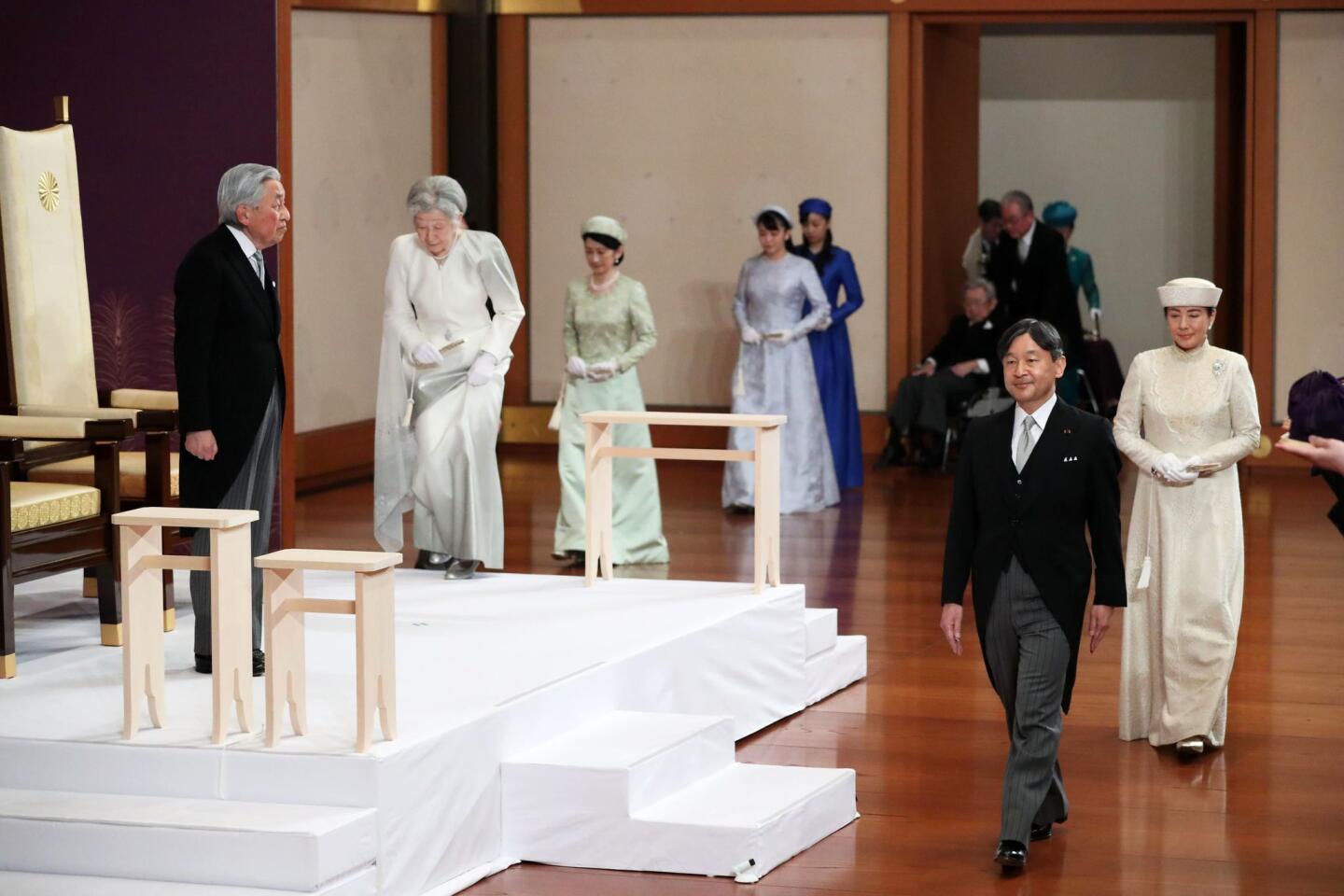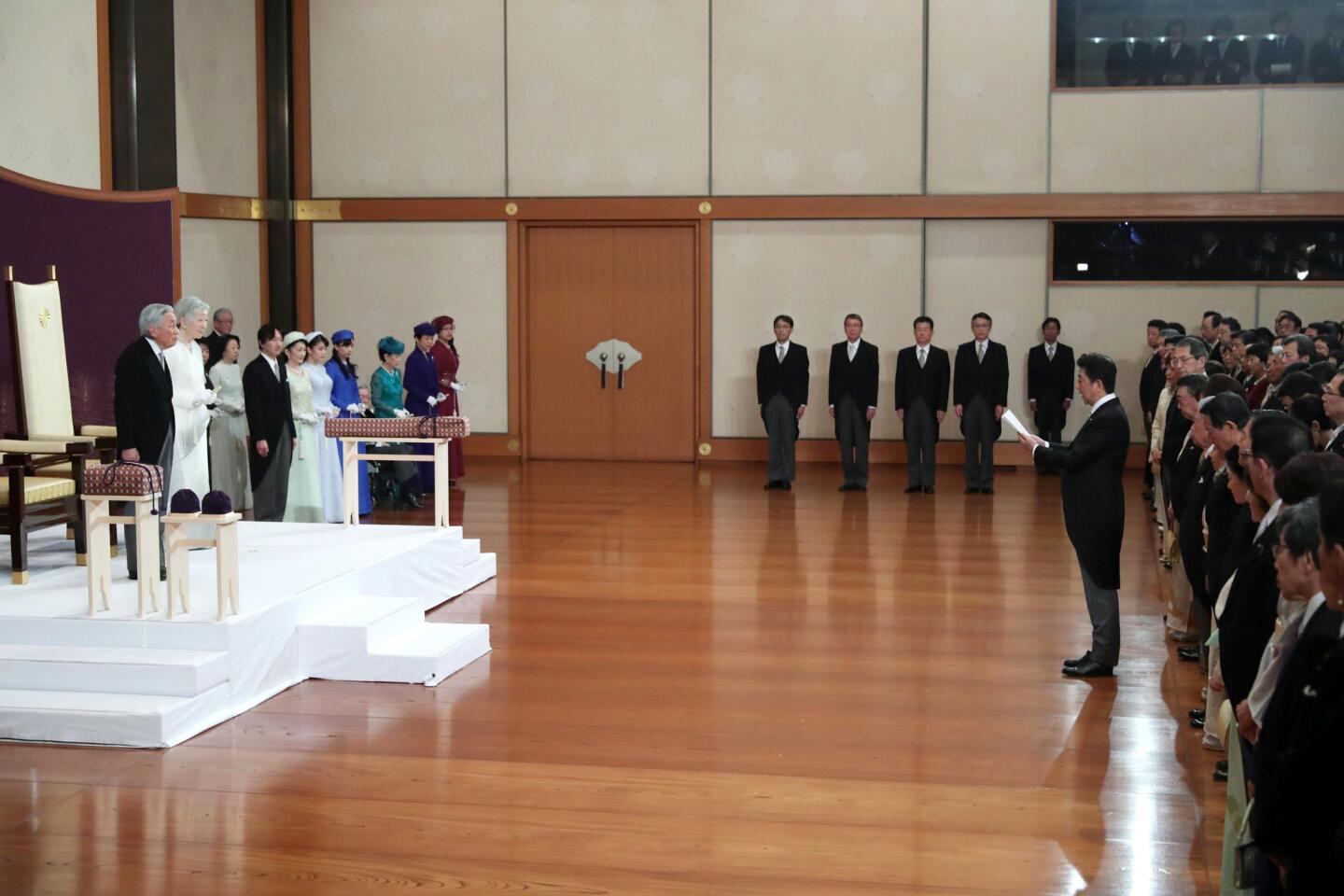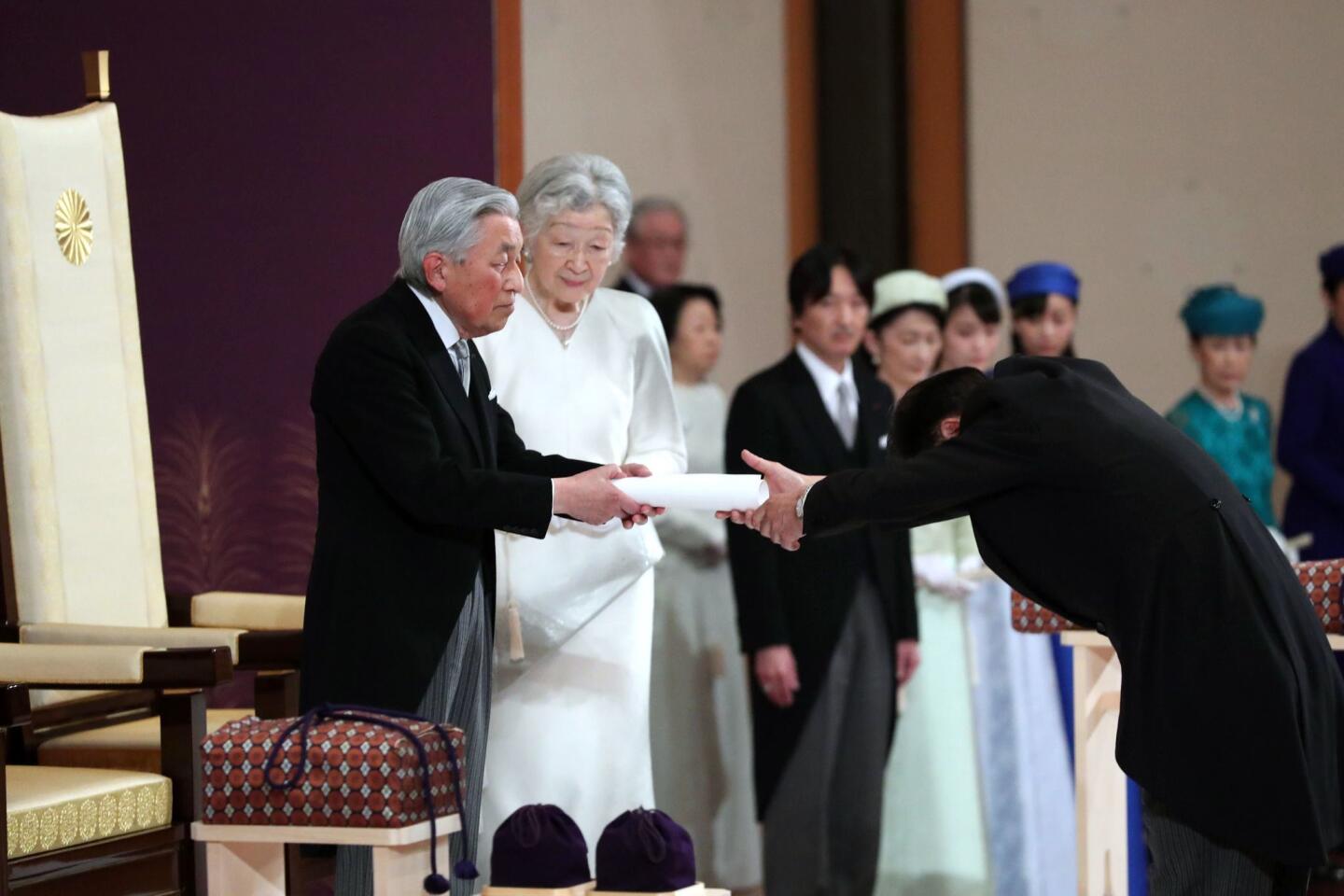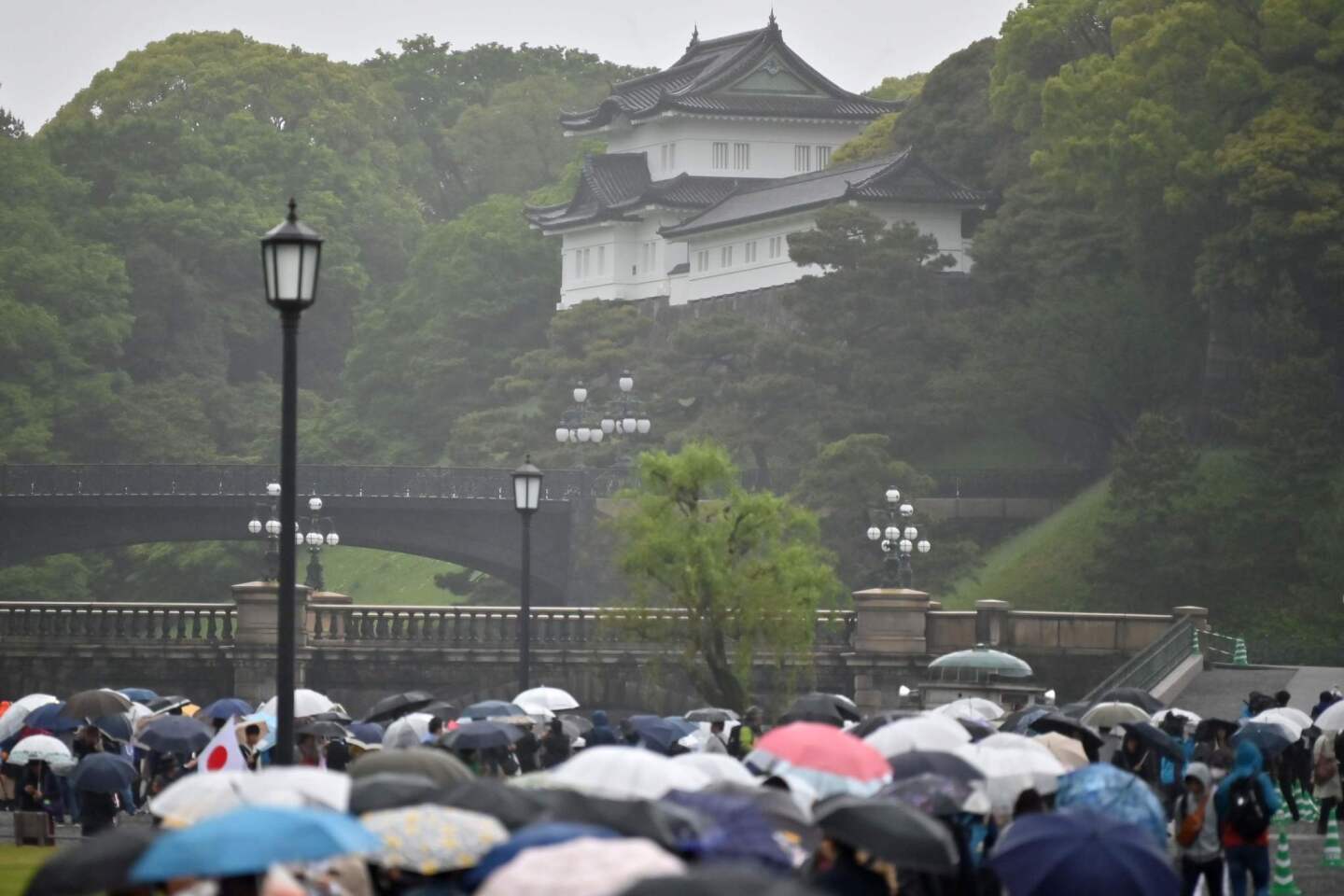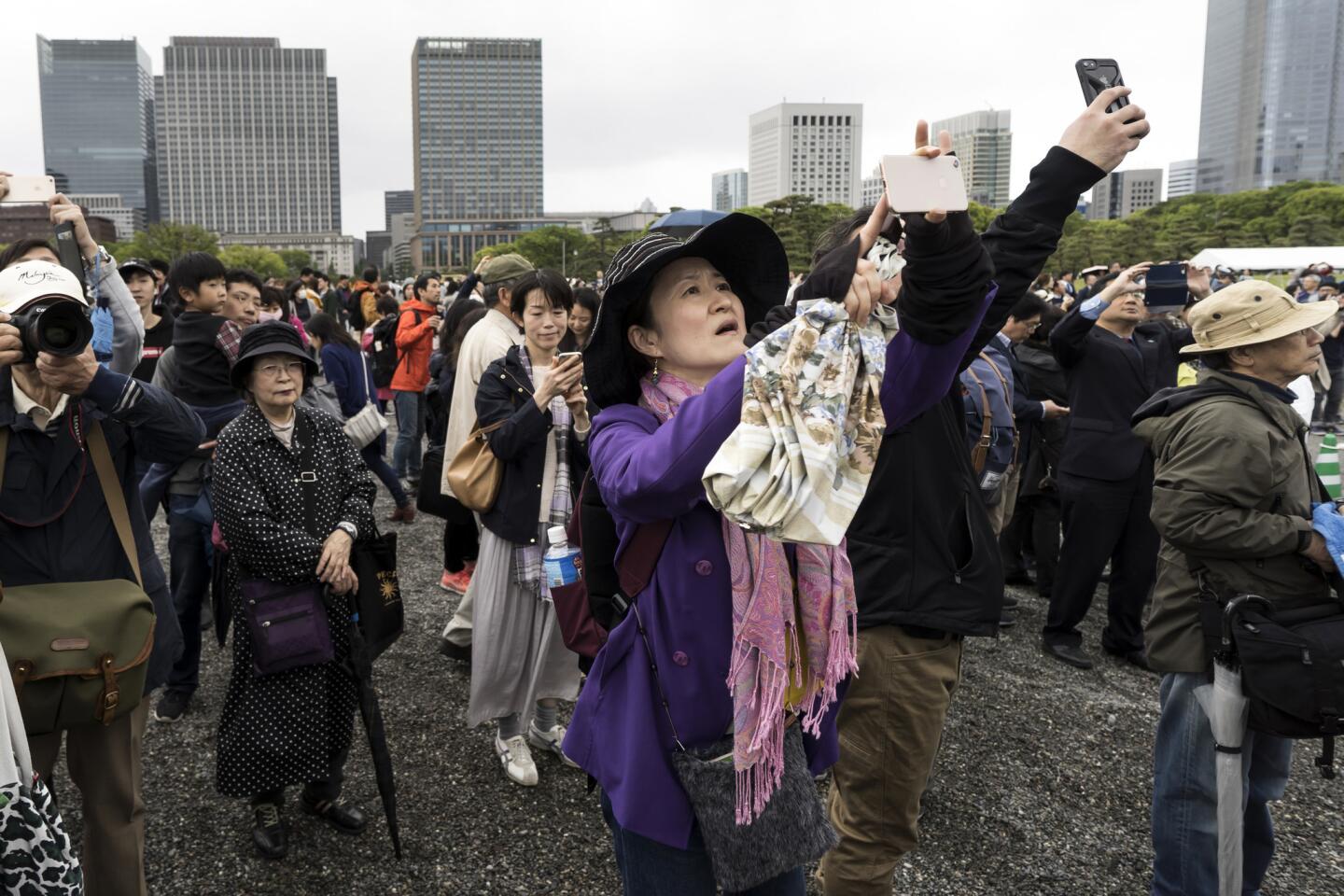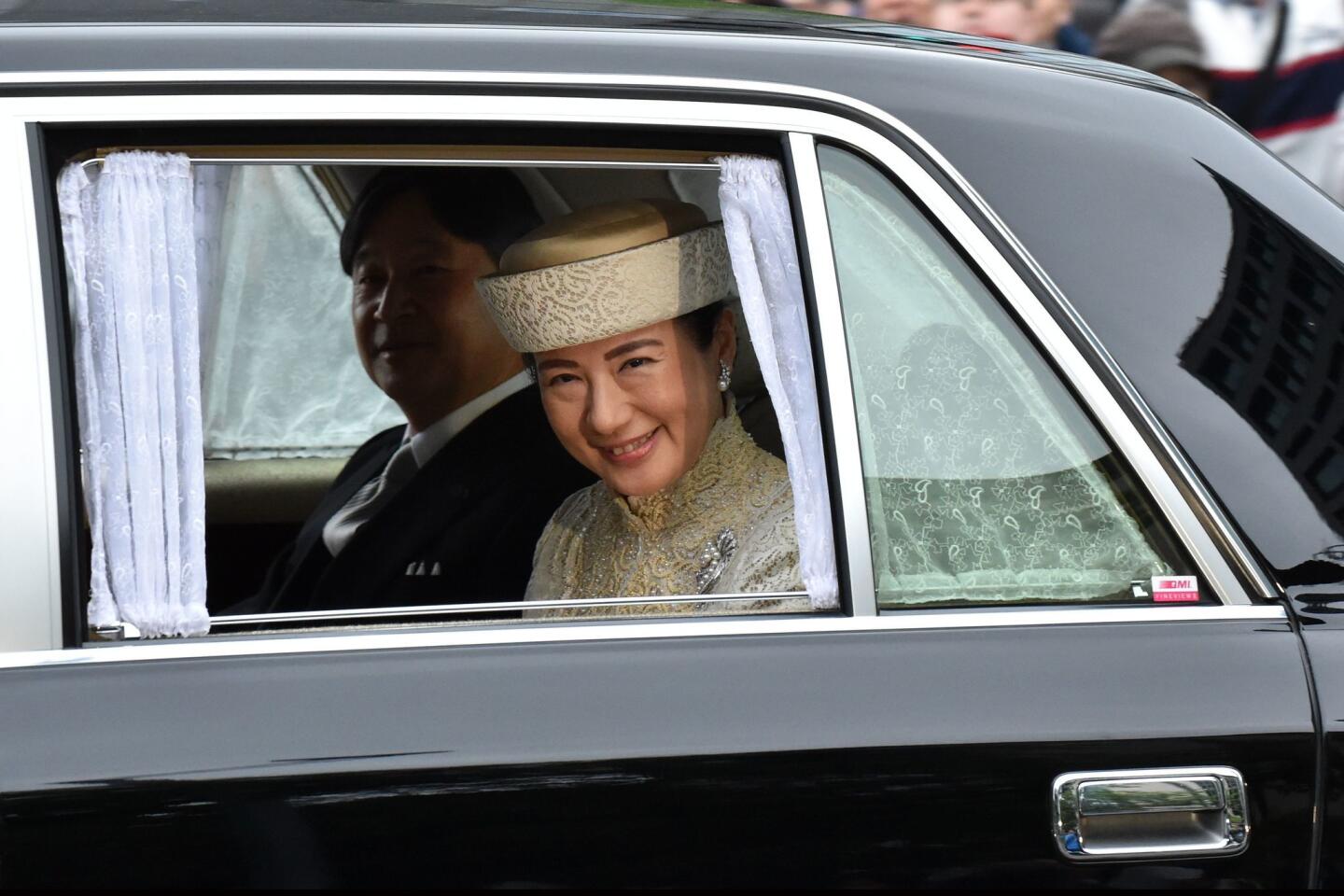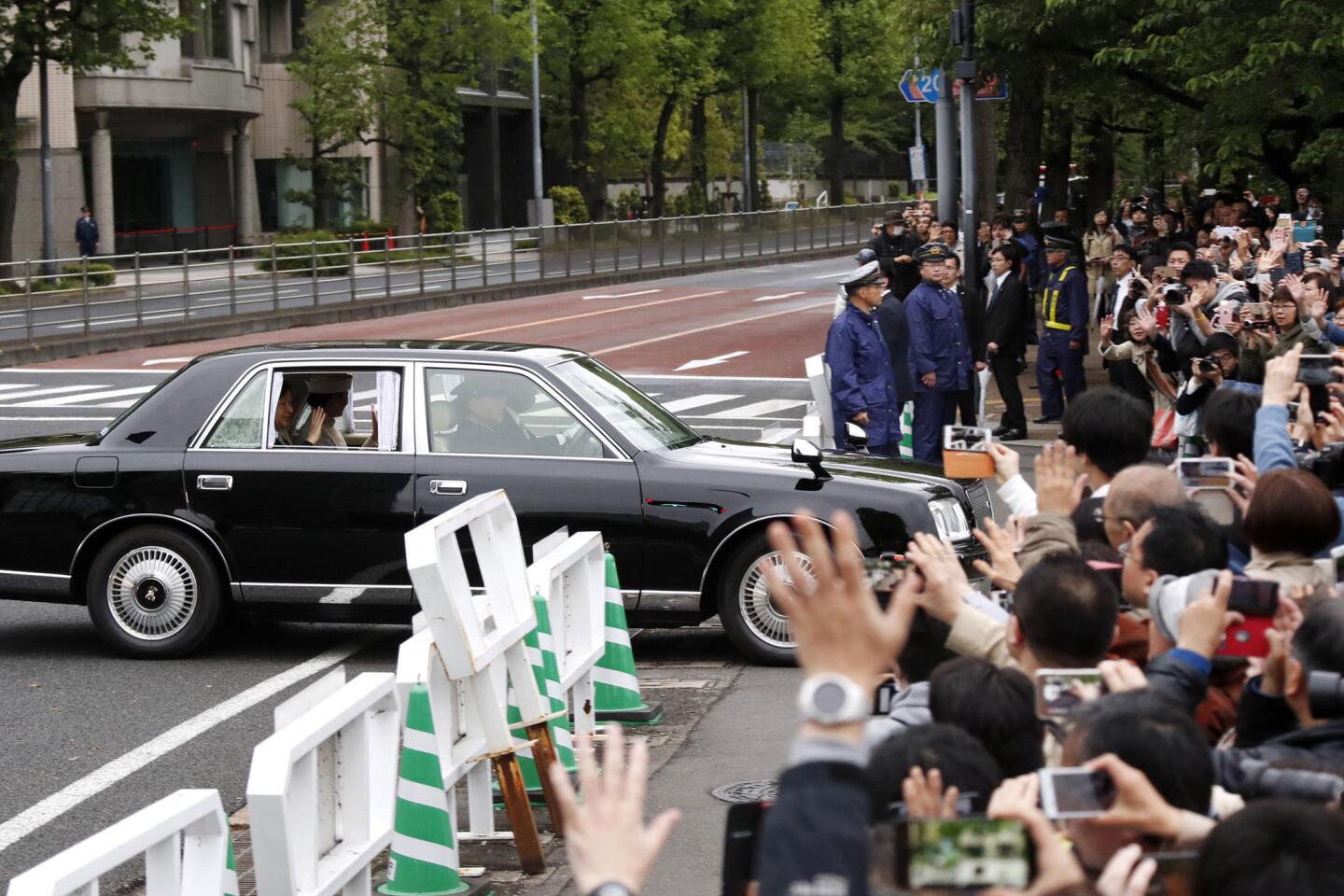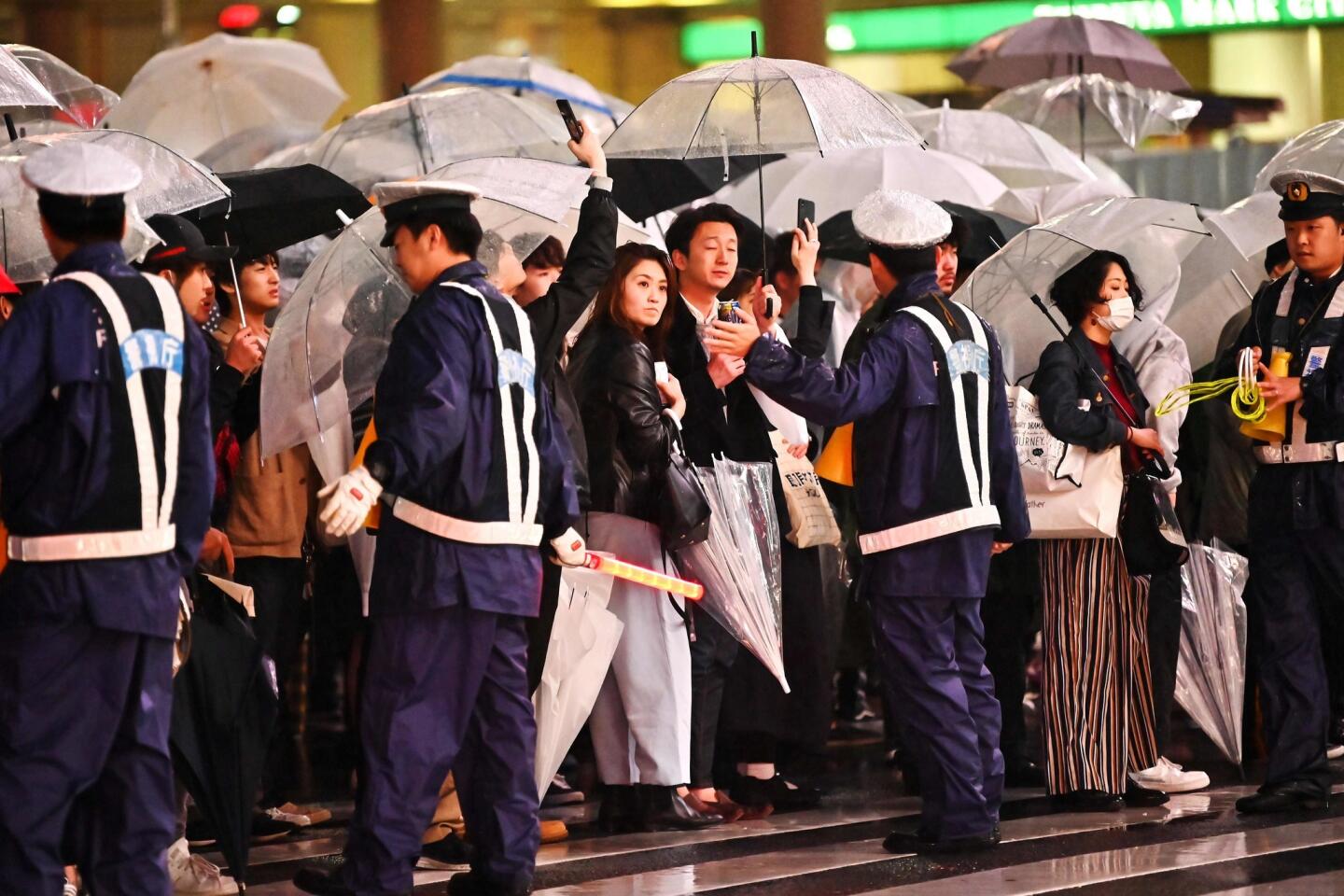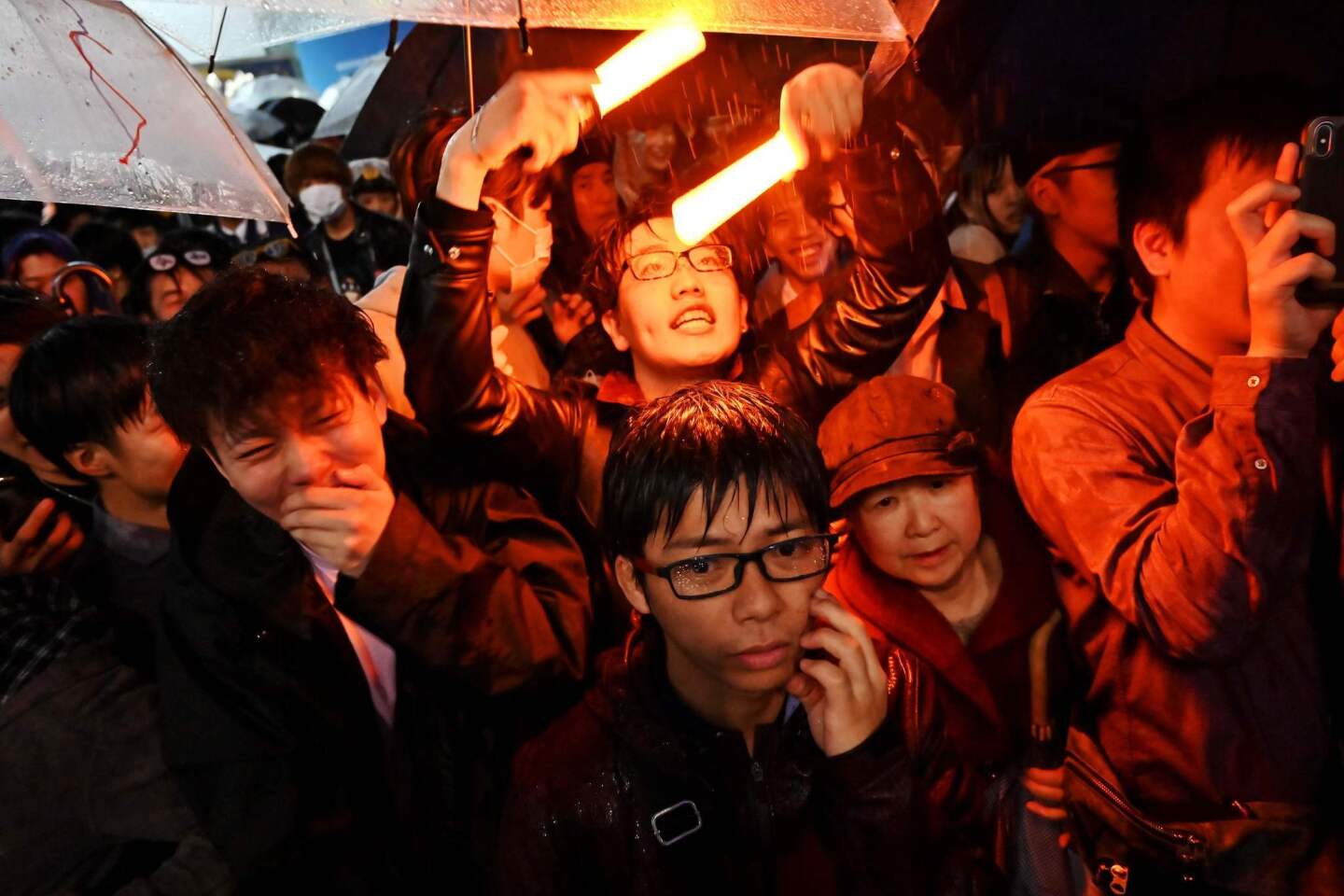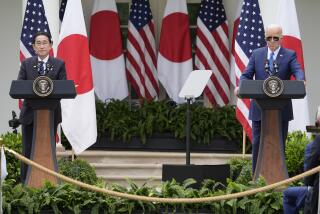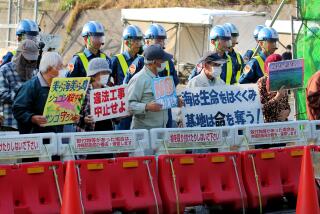Japan has a new emperor for the first time in 30 years
- Share via
Reporting from Tokyo — For 30 years, he stood as a symbol of postwar Japan — wrestling with the memory of military aggression and defeat, persevering through natural disasters and guiding the nation through evolving questions of identity.
On Tuesday afternoon, Emperor Akihito officially abdicated that role, stepping down from the Chrysanthemum Throne of Japan, becoming the first emperor to do so in more than two centuries. His reign expired at the stroke of midnight.
“Today, I completed my role as emperor,” Akihito said.
“Since ascending the throne 30 years ago, I have performed my duties as emperor with a deep sense of trust in and respect for the people. I consider myself most fortunate to have been able to do so.”
Prime Minister Shinzo Abe, representing the nation, expressed “deep gratitude” to the emperor for sharing in the sorrows and happiness of the Japanese people.
Akihito was enthroned in 1990 in a $94-million, 10-day affair that was attended by 2,500 guests from around the world and incited protests from people opposed to the imperial system.
Tuesday’s ceremony, before about 300 guests in the Pine Room of the Imperial Palace in Tokyo, took all of 10 minutes. It was broadcast live on national television across Japan.
The emperor, dressed in a tailcoat and silver tie, slowly walked to a dais with two chairs in the middle of a wooden floor accompanied by his wife, Empress Michiko. He stared solemnly ahead as wrapped packages containing imperial regalia were placed before him. Abe, along with the guests, bowed deeply.
The following morning, his son Naruhito received the regalia and officially ascended to the throne in a minimalist ceremony.
In his first remarks as emperor, Naruhito said Wednesday that his father had served with “profound compassion” and that he would follow in his footsteps.
“I sincerely pray for the happiness of the people, development of the nation and peace in the world,” the new emperor said.
The only woman in the room was a government official, Satsuki Katayama, the minister of women’s empowerment. The ceremony was off-limits to the women of the imperial family.
Outside the palace, hundreds of Japanese gathered despite a light drizzle to pay their respects and take selfies to mark the final day of Akihito’s reign, even though none of the proceedings were visible to the public.
“I know we cannot see. We wanted to come here to feel close,” said Mariko Kawano, a 40-year-old English teacher who was in town from Kobe with her husband.
Kawano said that she rarely thinks about the imperial household in her daily life but that the transition nonetheless felt significant and that she appreciated the legacy Akihito will be leaving behind.
“He was very dedicated to achieving peace,” she said. “I could tell he had a sense of responsibility for the war, the burden of war.”
Ichiro Okazaki stood out from the crowd, holding a pole twice his height with a giant Japanese flag and yelling from beyond the blockade and toward the castle: “Thank you, thank you for working so hard for a long time.”
Okazaki, 69, said he’d come to show his gratitude to an emperor and empress who had cared about people.
“I appreciate and I’m happy that I was able to live with an emperor who was so wonderful,” he said.
Akihito, 85, said age and increasingly poor health made it difficult for him to carry out his duties as emperor. Lawmakers passed a one-time law to allow for his abdication. His father, Hirohito, had reigned until his death in 1989.
Stripped of its once-mighty political power after Japan’s defeat in World War II, the imperial household figures little in the lives of average citizens except as fodder for curiosity and as ceremonial figures.
But in his 30-year reign, Akihito brought the monarchy closer to the people. He won Japanese hearts and established a moral authority during a period when the throne could have faded into obsolescence, said Jeff Kingston, a professor at Temple University’s Tokyo campus and a scholar of modern Japan.
“He totally reinvented the role of the emperor,” Kingston said. “He saw how important it was to make the monarchy relevant to contemporary society. Why do we have this anachronism in modern Japan? That question was on a lot of people’s minds, but also the emperor’s.”
Akihito and Empress Michiko were subtle but stalwart champions of liberal, pacifist causes, advocating for the rights of the marginalized and for Japan to accept and atone for its aggressions in the first half of the 20th century.
Noriko Kawamura, a history professor at Washington State University and an author of a book on Hirohito, said perhaps the most direct U.S. equivalent to the emperor in modern Japan was the U.S. flag.
“Best way to survive without controversy is to be like the American flag — just wave,” she said.
But Akihito used the throne to delicately counterbalance a shift toward right-wing nationalism in politics in recent years under Abe. Akihito used increasingly strong language to apologize for Japan’s wartime belligerence and promoted peace while Abe advocated for revising the constitution to allow for Japan to again have an active military. Currently, the army is limited to defensive actions.
“We are all watching to see how the pendulum of patriotism and nationalism is swinging,” Kawamura said.
Naruhito, whose reign will officially be known as the era of Reiwa, or “beautiful harmony,” has echoed his father’s comments on the importance of peace.
He has also repeatedly spoken of the importance of diversity at a time when Japan is beginning to accept larger numbers of migrant workers in the face of a shrinking and rapidly aging population.
“He’s not an unknown figure in Japanese society at all.… We’ve known them for a long time. There’s a lot of overlap in their thinking,” said Takako Hikotani, a professor of modern Japanese politics and foreign policy at Columbia University.
Among the crowd gathered at Tokyo’s famed Shibuya district for the countdown to midnight were three migrant workers from Indonesia — two nursing care aides and a mechanic — who weren’t sure what the others had assembled for. The three friends, in their early 20s, had emerged from a K-pop concert.
Nearby, a group of five similarly aged Japanese medical students had been waiting for a couple of hours.
“It’s the rarest, most precious experience to see the transition,” said Masao Fujiwara, 18.
Kumiko Mochida, 54, spends most Saturday mornings with the imperial family — that is, with the long-running TV program about the royals, “Imperial Family Album.”
Mochida had brought her 22-year-old daughter, Miho, a preschool teacher who barely pays any attention to the emperor or his family, to the palace on the day of Akihito’s abdication because she wanted to pique her daughter’s interest. She said she felt it was important because the emperor espoused peace.
“I want her to be more like them,” she said. “They paved a new way, pioneered a new era.”
She said she is particularly taken with Empress Michiko, who raised her children herself, a decision that felt revolutionary at the time because it flew in the face of imperial tradition.
Mochida, a banker, snapped a selfie with her daughter with the palace in the background. She grew wistful recounting the last time there was a new emperor, when Akihito took the throne — a day she still remembers vividly.
Much like his last day, his first was overcast and drizzly, she recalled.
“The weather was gloomy like this,” she said. “A time of transition.”
More to Read
Sign up for Essential California
The most important California stories and recommendations in your inbox every morning.
You may occasionally receive promotional content from the Los Angeles Times.
